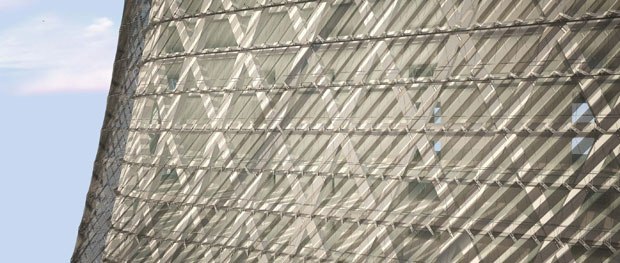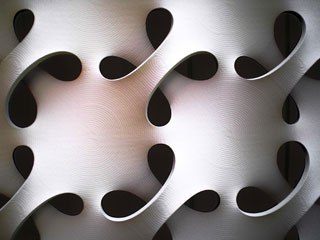This year, in keeping with the Evolve theme, SIGGRAPH has split its digital art gallery into two exhibits, and Eric Post explores how and why.
This summer at SIGGRAPH 2008, there will be two art galleries at the Los Angeles Convention Center (Aug. 11-15): Design and Computation and Slow Art. Both galleries will be accessible in their own open areas next to each other in Hall H and are very different yet complementary showings.
Design and Computation
Lira Nikolovska, Ph.D., will present the Design and Computation gallery. Fittingly, she received her Ph.D. in the Design and Computation program at the School of Architecture at M.I.T.
The Design and Computation gallery is comprised of works that show how these aspects of computer graphics may be used to demonstrate expressions of real life art.
Architecture is one very common way of blending art with mathematics, and certainly seems to dominate the gallery. Dr. Nikolovska was quick to point out that architecture doesn't really dominate this year even though it seems to. The 40 skyscrapers submitted this year comprise a single curated piece that was sought out for a particular gallery sponsor who requested submissions of concept work.
Dr. Nikolovska said, "Pushing the envelope is part of the process. Some are using Maya to make buildings but Maya is not designed for this. How far can a person push the software?" Of course, CAD tools were used to design some of the skyscrapers. Dr. Nikolovska said that a new trend is to script the facade rather than build it in a 3D program. 3ds Max with the architecture plug-ins are popular along with Revit Architecture by Autodesk. Rhino is used a lot. Some even use CATIA (Computer Aided Three dimensional Interactive Application), known more so for modeling planes. In fact, more and more, tools are being customized and off-the-shelf tools are pushed to the limits.
Some architects are even making use of rapid prototyping to visualize the finished product and make changes. A typical design may take two to three years on some buildings just to figure out the facade. With modern printing techniques, this time can be reduced by months. Hundreds of changes that are made to a building are sped up with the use of 3D tools and lead to complexity and craftsmanship being handled more easily. Hence, complexity and craftsmanship are part of the evaluation of the pieces in the gallery.
Outside of the one group of 40 is a 2.5-foot model called The Phare Tower, La Défense by Marte Doscher and Satoru Sugihara of Santa Monica. Scheduled to be built in Paris in 2012, this is a scripted work where the architect, instead of designing each part of the tower, inputs the variables, defines parameters for aesthetics, cost and performance, then selects from the alternatives generated by the software. Change a few variables, and a dramatic change in complex geometries can result. The Phare Tower used computational design for the "diagrid" or diagonal grid of the structure and the non-standard form.
Another architectural highlight is the Continua by Erwing Hauer and Enrique Rosado. Hauer has been sculpting since the 1950s and prior. One such category of sculptures is the infinite continuous surfaces that end up becoming modular structures in architectural applications. The curved surfaces are both aesthetic and designed to manage how light strikes the wall. The surfaces show diffusion on other surfaces and supports illumination from light bouncing from one surface to another. Essentially, the walls become art. Dr. Nikolovska simpy said, "I'm getting goose bumps just thinking about visiting his studio."
To top it off, architecture also has an occasional "organic" look to it. A piece called The Search of Form, The Search of Order: Gaudí and the Sagrada Familia by Carlos Barrios, School of Architecture and Planning, Washington, D.C., may look organic, but far from it in reality. Antonio Gaudí's work is not finished yet and, "it should not be associated with organic; it is based on the geometry of a plant," according to Dr. Nikolovska. Gaudí is believed to have studied the growth of the "abelia" plant. Gaudí's most famous work is in the Expiatory Temple of the Sagrada Familia in Barcelona. Commissioned in 1863 to complete the construction and oversee the work, Gaudí remained on the job until his death in 1926. This Temple is still under construction to this day.
Moving beyond the architecture, Dr. Nikolovska has expanded this Gallery to include other forms of analytical and generative methods of design.
When asked about this new theme for her gallery, Dr. Nikolovska said, "It is about contemporary development and design and tools of today. It is also about presidence - something new in software to help design something."
In India, floor patterns were drawn to start the day. The patterns were messages and there was a mathematical value to be found in them. The Kolam art is presented by professor Kelki Dhanesha and her students, Shashikala Sathyamurthy, Pallavi Naik and Samir Beltare from the Indian National Institute of Design in Bangalore. It captures a traditional art used at the entrance of a home to greet guests, honor deities or simply commemorate the beginning of a new day. The algorithms were passed from mother to daughter for centuries and have found their way into contemporary clothing and jewelry.
Algorithms are also formulated to create idealized mathematical curves and this works out well for origami designs. Jeannine Mosely presents Curved Origami this year at the Design and Computation gallery. That's right, not just straight line folds, the curved origami causes the two parts of the paper on the curve to not lie flat against each other. Thus most of the paper remains exposed to view.
In the 18th and 19th centuries, Chinese window grilles were built by craftsmen in complex patterns that referred to the way ice cracks when broken. After some study, it became obvious that this was not random. The patterns followed a form of fractals and it was merely a matter of figuring out the rules. Ice-rays presented by George Stiny from the Department of Architecture, M.I.T., captures the formula for triangles, quadrilaterals and pentagons.
The construction of Islamic Patterns presented by Craig S. Kaplan of the Computer Graphics Lab at University of Waterloo has mathematical formula as well. The Islamic patterns included calligraphy, stylized floral designs, architecture and abstract geometric star patterns. Some of these patterns are seen on mosques and tombs. The de-construction and reconstruction is tough and development of the tools to do this is new.
As one might imagine, these new tools that show design and computation had to be sought out and found. Hence, the curated nature of the Design and Computation gallery. Dr. Nikolovska said, "It took a lot of work to get people in on this and convince participants to go to SIGGRAPH."
Slow Art
Chaired by Lina Yamaguchi from Stanford, there is no shortage of submissions for the Slow Art gallery, and as such, the Slow Art Gallery consists of juried selections. Slow Art has one primary theme: time. Ask yourself in today's digital world of super fast computers and optimized software, if you were to create a work with this technology that said, "I want to stop and smell the roses," what would it look like? The answer may be seen in the Slow Art Gallery for 2008 at SIGGRAPH.
Yamaguchi said that because the gallery has been split into two separate showcases, "the Slow Art exhibit therefore is much smaller than past years' exhibits." The theme is more restrictive than in past themes. Submissions are presented in four categories, all of which tell the human story.
Erosion is the category for our material existence as seen through the wear of time and repetition. It is the visualization of entropy. Dark Days-New York, the visual of a man and his briefcase, walking alone at night, captures the repetition as imagined by Gabriele Peters from the University of Applied Sciences and Arts Dortmund, Dortmund Germany. Another work is the Life and Death of Energy Autonomous Devices by Anab Jain and Alex S. Taylor of Microsoft Research.
Hybrids are unique combinations. By definition, the hybrids are combinations of objects that may be natural and artificial or nostalgic and innovative. Through the contrasts, our understanding of the familiar is richened. Highlights include RealSnailMail presented Vicky Isley and Paul Smith of Bournemouth University, Poole, U.K. and Kevin Mack, the prominent vfx supervisor from Sony Pictures Imageworks (Speed Racer) with Neurosymphonic Self Reflection and Divine Instruments of Technology.

Rhythms portray time's patterns. Not just a moment in time, but what came before and what comes after. There is an element of play added to the Rhythms section such as the Skorpions: Kinetic Electronic Garments that move and reshape as presented by XS Labs by Joanna Berzowska and Di Mainstone with Marguerite Bromley, Marcelo Coelho, David Gauthier, Francis Raymond and Valerie Boxer. Funded by the Canada Council for Media Arts.
Traversal refers to path we take in life and our relationship with time. Presentations include Moving Still, an anaglyphic presentation by Santiago Caicedo, L'Ecole nationale supérieure des Arts Décoratifs, Paris, France.
"We made a deliberate attempt to view the exhibit as a whole and from that our themes emerged," said Yamaguchi. "In an effort to provide more curatorial guidance to attendees, we will have signage describing the themes within the gallery. For those who want a more detailed level of information, there are several opportunities: docent-led tours, available in several languages including Chinese, French, German, Italian, Japanese and Korean; we will also have kiosk stations available for downloading a self-paced audio tour, also available in these languages. Finally, we have scheduled a series of informal artist's talks. We have at least eight of these scheduled so far, but dependent on time and artist's availability we may have more.
"The pieces were evaluated based on criteria such as: concept, novelty, interest (appeal) and proposal quality (quality, craft, completeness). There were many really great submissions, but ultimately adherence to the Slow Art theme and space considerations played a big role in eliminating works. Also, once the set of accepted submissions began to evolve, we tried to select pieces that would complement each other, or provide an interesting counterpoint to other selections."
Yamaguchi singled out the 3D work of Tim Borgmann: fragment (Silhouette) and fragment (Glint), which emphasize a stopping-time effect displayed as stills using SOFTIMAGE|XSI for particle effects and Photoshop, as well as the stereoscopic piece by Mark Stock, Smoke Water Fire: a digital animation of a deforming blob of fluid slowed down and stripped of environmental context in order to explore the shape of ephemeral media.
Slow Art is a growing trend. Along with slow food and now slow city design that focuses on restoring and improving quality of life, slow art has the potential to bring back the traditional and familiar scenes of historical fine art throughout the ages.
Eric Post is an attorney, journalist, computer graphic artist, helicopter pilot/mechanic and former pastor. Although he is a traditional artist, he enjoys modeling and landscape scenes in CG and uses various applications for medical illustrations at his office. From 2004-2006, Post was senior technical editor for the Renderosity magazine and e-zine. From 2006-2007, Post served as a staff writer for the Renderosity Front Page News, and edited various Renderosity publications.













